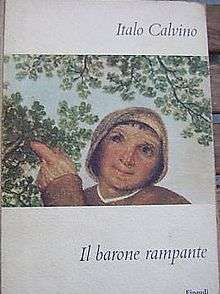The Baron in the Trees
 First edition | |
| Author | Italo Calvino |
|---|---|
| Original title | Il barone rampante |
| Language | Italian |
| Genre | Fiction novel |
| Published | 1957 |
| Publisher | Giulio Einaudi |
| ISBN | 0156106809 |
The Baron in the Trees (Italian: Il barone rampante) is a 1957 Italian novel by Italo Calvino. Described as a conte philosophique[1] and a metaphor for independence, it tells the adventures of a boy who climbs up a tree to spend the rest of his life inhabiting an arboreal kingdom. Calvino published a new version of the novel in 1959.
Plot
The story of twelve-year-old Cosimo Piovasco di Rondò is narrated by his younger brother, Biagio. Set in Liguria near the French Riviera, the two brothers belong to a noble 18th-century family whose estate is located in the vast forest landscapes of Ombrosa. The regions of Italy have not yet united and the Ligurian Coast is not ruled by a legitimate king.
In a rebellious fight after refusing to eat a dinner of snails prepared by Battista, his sadistic sister, Cosimo climbs up a tree and decides never to come down again. He has had enough of family and decorum, his proper role as a future Baron, and of everything on the ground. Initially helped and sometimes cared for by Biagio, the young Baron eventually becomes self-sufficient but finds that the more he distances himself from others in order to see them from a new point of view,[2] the more he helps everyone on the earth. His love for a young woman named Viola changes the course of the lives of everyone: Cosimo, Viola, Biagio, and the community of Ombrosa.
Reception
The Baron in the Trees is the second volume in the fantasy trilogy, Our Ancestors with The Cloven Viscount (1952) and The Nonexistent Knight (1959) comprising the first and third volumes, respectively. The novel received the prestigious Viareggio Prize in 1957.
On publication, various Italian critics complained of "the 'tired' feel of the plot in the second half of the novel"[3] while distinguished novelist and critic Elio Vittorini considered the "stylistic disunity between the early and later chapters" was a problem.[4] Despite these perceived flaws, critic Martin McLaughlin argues that the novel "remains something of a tour de force in Calvino's oeuvre. It is an extraordinarily successful attempt to reproduce a utopian, philosophical conte for the 1950s, with a whole range of intertextual allusions and a sophisticated parody of the poetics of the early English moralising novel as practised by Richardson and parodied by Fielding".[5]
Together with If on a Winter's Night, a Traveller (1979), The Baron in the Trees is Calvino's biggest-selling work of fiction.[6]
Notes
Further reading
- Pacini, Giulia (2014). "Arboreal and Historical Perspectives from Calvino's Il barone rampante". Romance Studies. 32 (1): 57–68. doi:10.1179/0263990413Z.00000000058.
External links
- Illustrations to The Baron in the Trees by French artist Yan Nascimbene